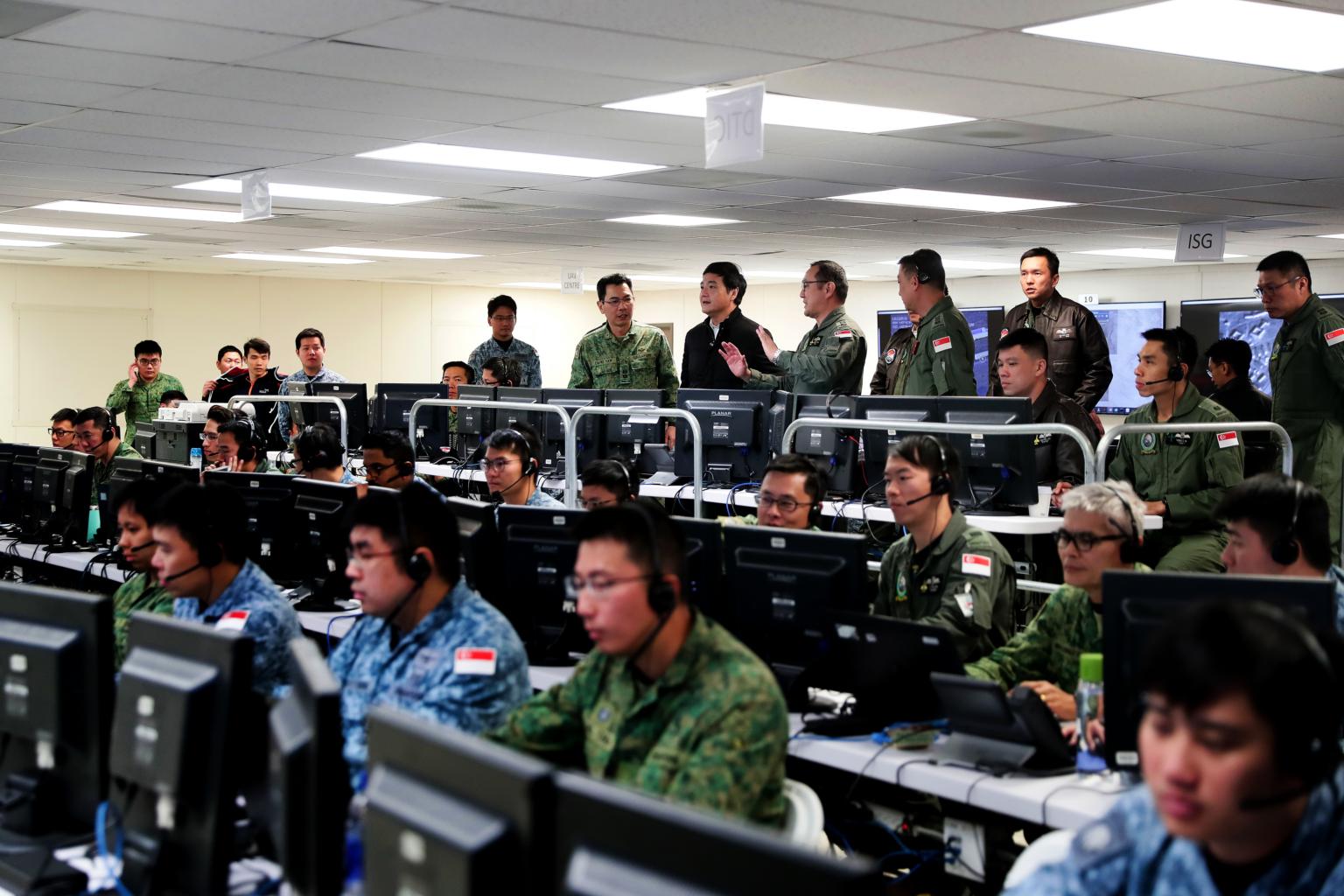SAF command post at Ex Forging Sabre enhanced with AI for more effective strike missions
Sign up now: Get ST's newsletters delivered to your inbox

Senior Minister of State for Defence Heng Chee How (back row centre, in black) at the command post for Exercise Forging Sabre, at Mountain Home Air Force Base in Idaho on Oct 9, 2019.
ST PHOTO: KELVIN CHNG
Follow topic:
MOUNTAIN HOME - At the command post where the Singapore Armed Forces' (SAF's) strike operations are orchestrated, potential enemy targets appear on a video feed taken from a Heron 1 unmanned aerial vehicle (UAV).
These target vehicles are automatically marked and classified according to their threat level, based on factors such as the type of weapons they might be carrying.
This process, previously done by human operators, is now aided by artificial intelligence (AI) and video analytics with a newly-developed software known as the Automatic Target Detection module by the Defence Science and Technology Agency (DSTA).
This is one of the upgrades that the command post at Exercise Forging Sabre in the American state of Idaho has received this year, boosting the SAF's ability to orchestrate strike operations swiftly.
The biennial integrated strike exercise conducted at Mountain Home Air Force Base involving around 600 soldiers is held from Sept 30 to Thursday (Oct 10).
Another enhancement to the command post - called the Target Look-Ahead capability - calculates how long it would take a target vehicle to reach an area where it can be taken out, using factors such as speed, direction of movement, and potential routes.
Target engagement information given to strike assets is thus more precise and accurate.
The exercise's air director, Colonel Aldrin Tan, who is also overall in-charge of the command post, said the enhancements help his staff come to a faster appreciation of situation and recommend decisions to him more quickly.
"Previously my battle staff that communicates with the fighters really have difficulty estimating how much time it takes for the target to reach his engagement area," he noted.
"It was an educated guess - this looks like two kilometres, I think he's travelling at 50kmh, then he does maths - so it was more prone to errors.
"But now with this Target Look-Ahead feature, the computer does it for them and it displays how much time it takes for the target to get there."
On Wednesday (Oct 9, US time), Senior Minister of State for Defence Heng Chee How witnessed the SAF conducting strike operations on multiple static and moving targets. He was accompanied by Chief of Air Force, Major-General Kelvin Khong.
He told reporters: "We're able to do this because of the specific facilities that we are training in here in the United States.
"And the open expanse, as you can see, this is not something that we have in Singapore, and the ability for our forces to train in such terrain enables us to acquire and hone our capabilities much better and faster."
The Automatic Target Detection software is being tested for the first time in a major exercise at Forging Sabre.

DSTA engineer Joshua Lim, 24, who is part of the team that developed it, said that after observing the operators looking at the Heron 1 video feed, they realised some processes could be automated to reduce their cognitive load.
He told reporters that the software works almost instantly: "One of the key considerations for this type of mission is how we cannot have any delay in the video, because the commanders have to make very timely decisions.
"So we cannot afford to have the AI run slow; they need to see the updates in real-time."
Data given to the AI to train it include information from past Forging Sabre exercises and open-source information such as images of vehicles.
However, human expertise still plays an important role in generating intelligence based on data gathered by the Heron 1.
Military Expert 4 (ME4) Joyce Tan, who is an Air Imagery Intelligence Expert, analyses still images to provide the why, where and how of potential targets to deepen the command post's understanding of the battlefield situation.
For example, if there are targets with vehicular movement, she will look for places that are close to roads or open spaces where they might be deployed.
ME4 Tan, 29, said her role requires "a good eye for detail, and being able to remember if things have changed over time, such as whether potential enemy targets have moved".
Once enemy targets are confirmed, strike assets like the F-16s could be called in to destroy them.
F-16 pilot, Captain Nigel Wong, 27, said the fighter jet can drop either the 500-pounder GBU-12 or the 2000-pounder GBU-10 laser guided bombs. They can be guided by the F-16 itself or by another unit, such as the Heron 1.
The Heron 1 is able to process an image of the ground better because of its higher-fidelity sensors and long endurance, he said.
"Another reason why we might do cooperative lasing with the UAV is weather. If we can't see the target due to bad weather, the UAV can go lower and lase the target for us as we drop the bomb through the cloud deck," he added.

